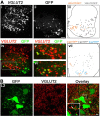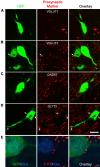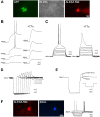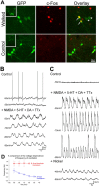Conditional rhythmicity of ventral spinal interneurons defined by expression of the Hb9 homeodomain protein
- PMID: 15958737
- PMCID: PMC6724883
- DOI: 10.1523/JNEUROSCI.0274-05.2005
Conditional rhythmicity of ventral spinal interneurons defined by expression of the Hb9 homeodomain protein
Abstract
The properties of mammalian spinal interneurons that underlie rhythmic locomotor networks remain poorly described. Using postnatal transgenic mice in which expression of green fluorescent protein is driven by the promoter for the homeodomain transcription factor Hb9, as well as Hb9-lacZ knock-in mice, we describe a novel population of glutamatergic interneurons located adjacent to the ventral commissure from cervical to midlumbar spinal cord levels. Hb9+ interneurons exhibit strong postinhibitory rebound and demonstrate pronounced membrane potential oscillations in response to chemical stimuli that induce locomotor activity. These data provide a molecular and physiological delineation of a small population of ventral spinal interneurons that exhibit homogeneous electrophysiological features, the properties of which suggest that they are candidate locomotor rhythm-generating interneurons.
Figures







Similar articles
-
Locomotor-like rhythms in a genetically distinct cluster of interneurons in the mammalian spinal cord.J Neurophysiol. 2005 Mar;93(3):1439-49. doi: 10.1152/jn.00647.2004. Epub 2004 Oct 20. J Neurophysiol. 2005. PMID: 15496486
-
Heterogeneous electrotonic coupling and synchronization of rhythmic bursting activity in mouse Hb9 interneurons.J Neurophysiol. 2007 Oct;98(4):2370-81. doi: 10.1152/jn.00338.2007. Epub 2007 Aug 22. J Neurophysiol. 2007. PMID: 17715199
-
Electrical coupling between locomotor-related excitatory interneurons in the mammalian spinal cord.J Neurosci. 2006 Aug 16;26(33):8477-83. doi: 10.1523/JNEUROSCI.0395-06.2006. J Neurosci. 2006. PMID: 16914672 Free PMC article.
-
Strategies for delineating spinal locomotor rhythm-generating networks and the possible role of Hb9 interneurones in rhythmogenesis.Brain Res Rev. 2008 Jan;57(1):64-76. doi: 10.1016/j.brainresrev.2007.06.025. Epub 2007 Aug 14. Brain Res Rev. 2008. PMID: 17905441 Free PMC article. Review.
-
The role of genetically-defined interneurons in generating the mammalian locomotor rhythm.Integr Comp Biol. 2011 Dec;51(6):903-12. doi: 10.1093/icb/icr022. Epub 2011 May 15. Integr Comp Biol. 2011. PMID: 21576118 Review.
Cited by
-
Spatial organization of cortical and spinal neurons controlling motor behavior.Curr Opin Neurobiol. 2012 Oct;22(5):812-21. doi: 10.1016/j.conb.2012.07.002. Epub 2012 Jul 27. Curr Opin Neurobiol. 2012. PMID: 22841417 Free PMC article. Review.
-
Serotonin controls initiation of locomotion and afferent modulation of coordination via 5-HT7 receptors in adult rats.J Physiol. 2017 Jan 1;595(1):301-320. doi: 10.1113/JP272271. Epub 2016 Aug 8. J Physiol. 2017. PMID: 27393215 Free PMC article.
-
Defining the excitatory neurons that drive the locomotor rhythm in a simple vertebrate: insights into the origin of reticulospinal control.J Physiol. 2009 Oct 15;587(Pt 20):4829-44. doi: 10.1113/jphysiol.2009.175208. Epub 2009 Aug 24. J Physiol. 2009. PMID: 19703959 Free PMC article.
-
Shining light into the black box of spinal locomotor networks.Philos Trans R Soc Lond B Biol Sci. 2010 Aug 12;365(1551):2383-95. doi: 10.1098/rstb.2009.0322. Philos Trans R Soc Lond B Biol Sci. 2010. PMID: 20603359 Free PMC article.
-
Hindbrain V2a Neurons Pattern Rhythmic Activity of Motor Neurons in a Reticulospinal Coculture.Front Neurosci. 2019 Oct 17;13:1077. doi: 10.3389/fnins.2019.01077. eCollection 2019. Front Neurosci. 2019. PMID: 31680817 Free PMC article.
References
-
- Aizenman CD, Linden DJ (1999) Regulation of the rebound depolarization and spontaneous firing patterns of deep nuclear neurons in slices of rat cerebellum. J Neurophysiol 82: 1697-1709. - PubMed
-
- Arber S, Han B, Mendelsohn M, Smith M, Jessell TM, Sockanathan S (1999) Requirement for the homeobox gene Hb9 in the consolidation of motor neuron identity. Neuron 23: 659-674. - PubMed
-
- Arshavsky YI, Deliagina TG, Orlovsky GN, Panchin YV, Popova LB, Sadreyev RI (1998) Analysis of the central pattern generator for swimming in the mollusk Clione Ann NY Acad Sci 860: 51-69. - PubMed
-
- Baev KV, Degtiarenko AM, Zavadskaia TV, Kostiuk PG (1979) Impulse activity of interneurons of the lumbar portion of the spinal cord during the late long discharges in the motor nerves of immobilized thalamic cats. Neirofiziologiia 11: 236-244. - PubMed
Publication types
MeSH terms
Substances
Grants and funding
LinkOut - more resources
Full Text Sources
Other Literature Sources
Molecular Biology Databases
Research Materials
